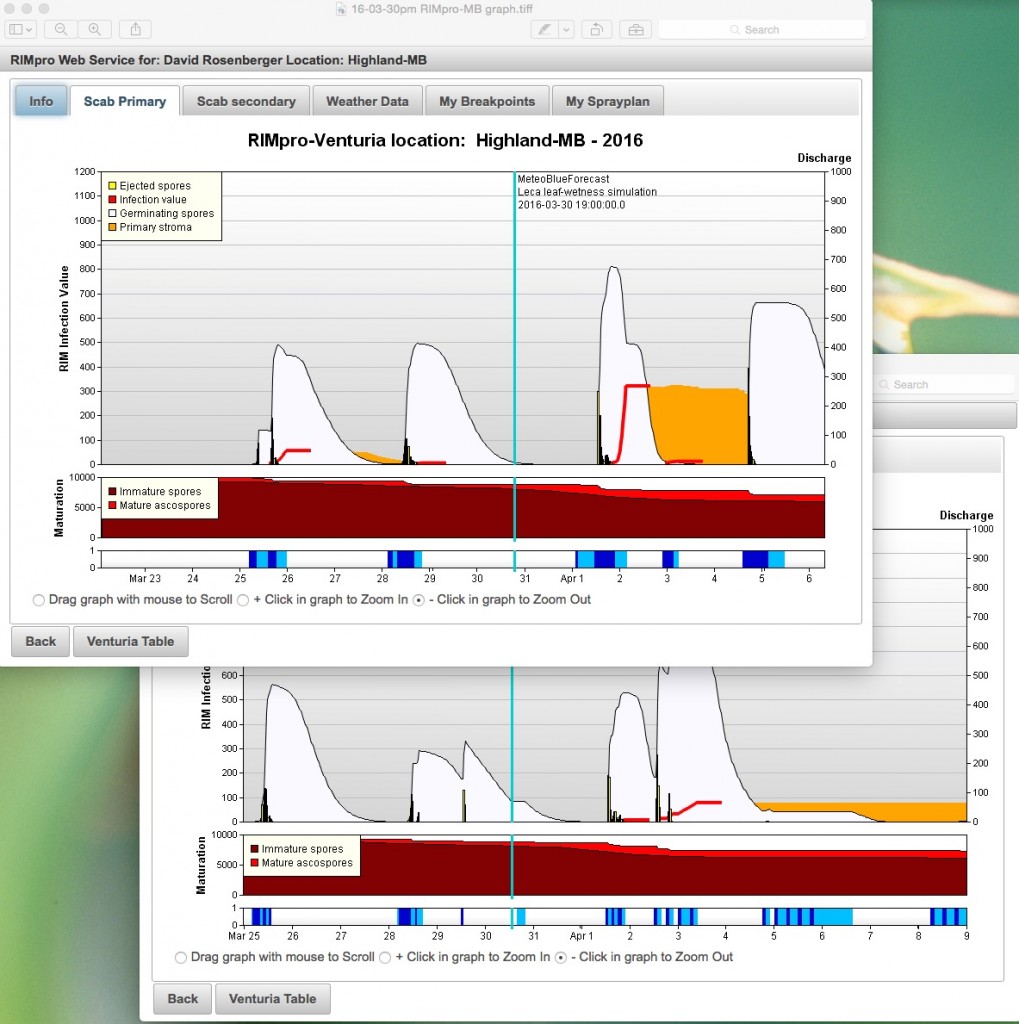The predicted scab infection risk for April 1-3 has diminished somewhat, but caution is still advised. Below are the RIMpro graphs for the two systems that I described in a post yesterday morning that was titled “Weather or Not.” The RIM value for the Highland-MB station has now dropped to about 300, which is the risk level that we are currently using as the threshold for economically significant infection periods in clean orchards. The RIM-value for the Highland-N system has remained rather steady over the past 48 hours and indicates an even lower risk of infection.
NOTE: In my two previous posts, I erroneously used the right-hand axis to reference RIM-values indicated by the red line. Thus, yesterday I indicated that the RIM-value for the Highland-MB graph was near 600 whereas it really was over 700 when read using the left-hand RIM-value axis. As forecasts have been modified over the past 48 hours, the RIM-value for the predicted wetting periods on April 1-3 has dropped from over 700 to slightly over 300 on the Highland-MB graphs.
Those who have not yet applied any fungicide in their orchards will want to closely monitor both the bud stage (how much green tissue is really out there) and wetting periods as they develop over the next few days.
If the forecasted rains for April 1 to 3 ultimately bring us more lengthy wetting periods than currently forecasted, then it may be wise to apply post-infection fungicides ASAP after the infection events (perhaps Saturday morning between showers). The two fungicides in the AP class, Vangard and Scala, will both provide about 72 hr of post-infection activity counting from the start of the wetting period. Inspire Super, which contains Vangard plus the DMI fungicide difenoconazole, should be even more effective so long as the scab population in the orchard is not highly resistant to DMI fungicides. However, all of these fungicide need to dry on the leaves to be fully effective. All of them should also be applied with mancozeb or captan, but these two contact fungicides will only provide 12-18 hours of post-infection activity (counting from the start of rains) under the warm conditions that are predicted.
Although the scab risk from the predicted rains seems to be diminishing, it is important to note that if scab gets started this early in the season, it can potentially cause problems throughout the rest of the season and risks of getting fruit scab due to secondary spread will be significantly increased. Factors that suggest scab risk over the next few days will be minimal include the forecasts as noted above plus the fact that most orchards had very little scab last year, so inoculum levels are low.
On the flip side, one factor that concerns me is the fact that this will be a warm rain and warm rains trigger far more release of mature spores than cold rains. The RIMpro model includes temperatures during rains in assessing risks, but this is the kind of scenario where I would be more comfortable if we had more experience with RIMpro and if we had a more definitive biofix for starting the RIMpro program this year.
Given the uncertainties, as I suggested yesterday, decisions about whether or not to spray ahead of these predicted rains are very much dependent on individual approaches to risk management.

